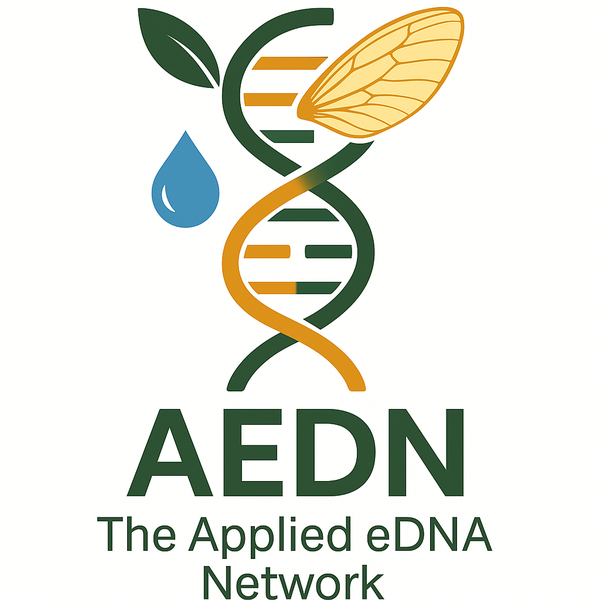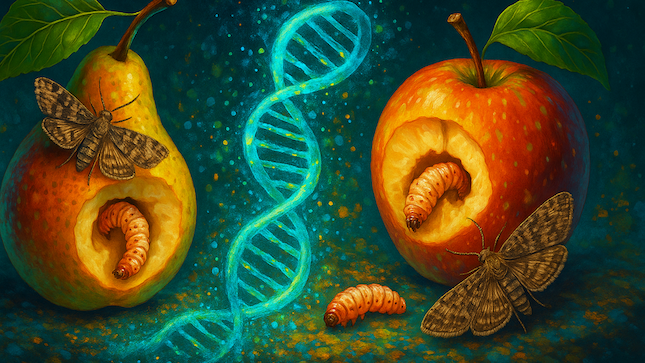Fruit-boring moths such as the oriental fruit moth (Grapholitha molesta) and the peach fruit moth (Carposina sasakii) represent some of the most damaging pests in orchard systems worldwide. Their larvae tunnel into apples, pears, peaches, and other fruit, compromising both yield and quality. In severe cases, infestations can result in crop losses of up to 70–80%, with significant financial and trade implications for growers and exporters. The risks are amplified in the context of international trade, where pest contamination can result in rejected shipments and lead to breaches of quarantine regulations.
Recent research from China addresses these challenges through novel application of environmental DNA (eDNA) technology, offering a rapid, sensitive, and non-destructive method for detecting fruit-boring moths, even in early or cryptic stages of infestation.
Why eDNA for Fruit-Boring Moths?
The larvae of fruit-boring moths feed inside the fruit, where they are difficult to detect. Symptoms often appear too late, after significant damage has already occurred. Traditional identification methods rely on dissection and extraction of larvae or adult insects, followed by morphological or DNA barcoding analysis. These approaches are time-consuming, labour-intensive, and impractical at scale, particularly for large shipments or routine field checks.
The Oriental fruit moth has a broad host range, attacking apples, pears, peaches, plums, and other fruits across most temperate growing regions. The peach fruit moth is similarly destructive, with a range extending from East Asia to North America and Australia. A fast and scalable detection method that does not rely on visible symptoms or destructive sampling is urgently needed.
What Makes eDNA a Game-Changer?
Environmental DNA refers to genetic traces shed by organisms into their surroundings, such as skin cells, frass, or other tissue remnants. These fragments can be extracted from water, soil, or air without needing to locate or handle the organism itself.
For insect pests, especially internal fruit borers, eDNA offers several advantages:
- Non-destructive sampling: Infested fruit need not be cut open.
- High sensitivity: Even minute traces of DNA can be detected.
- Speed and scalability: eDNA workflows can screen multiple samples in parallel and can be adapted for high-throughput inspection.
While eDNA methods are well established in aquatic systems, their application to terrestrial insect pests is emerging. In this context, larvae feeding within fruit create an ideal niche, shedding sufficient DNA into the fruit tissue for detection and identification.
The Method: From Fruit to Filter
Sample Collection and Soaking: Fruit samples—typically apples or pears suspected of infestation — were soaked in sterile water for 15 minutes. This brief immersion releases any residual DNA left by larvae within the fruit into the water.
Filtration and Enrichment: The method employed two filter layers: an upper membrane with a larger pore size (10 microns, mixed cellulose ester or MCE) to trap debris and a lower, finer filter (0.45 microns, cellulose acetate or CA) optimised for retaining DNA particles and minimising clogging. After filtration, the lower membrane, which captures the DNA, was rolled up and stored in a centrifuge tube at -20°C until extraction.
DNA Extraction and PCR Detection: To recover eDNA from the filter, a commercial DNA extraction kit (e.g., QIAGEN DNeasy Blood and Tissue Kit) was used, with minor adjustments to buffer volumes and proteinase K concentrations to improve yield. For detection, the team developed highly specific primers targeting the mitochondrial COI gene region for each moth species. These primers generate short PCR amplicons and were chosen because environmental DNA fragments tend to degrade, and shorter targets increase the likelihood of successful detection. Detection limits reached 0.1 ng/μL for the oriental fruit moth and 0.01 ng/μL for the peach fruit moth—comparable to, or exceeding, the sensitivity of standard PCR or isothermal techniques.
Field Testing Across China
The method was tested at eight key fruit-growing sites across China, including Beijing, Liaoning, Xinjiang, Hebei, and Shandong. Both laboratory-prepared and field-collected fruit were included.
Results were promising: eDNA detection identified infestations that were missed by manual dissection. For example, in Yanqing District (Beijing) and Xingcheng (Liaoning), oriental fruit moth DNA was detected in samples where no larvae were found by traditional means. This underscores eDNA’s ability to detect early-stage or low-density infestations, which is crucial for timely intervention.
The approach also revealed mixed infestations, highlighting its value in integrated pest management. DNA barcoding of dissected larvae was used to cross-validate field detections, reinforcing the method’s accuracy.
Limitations and Future Improvements
As with any emerging tool, the study identified several areas for refinement:
- False Positives/Negatives: Contamination risks (e.g., from sampling tools or surfaces) may generate false positives, while low infestation levels may lead to false negatives. Increasing sample replicates and confirming results with barcoding can mitigate these issues.
- Database Gaps: Species identification relies on reference sequences. Gaps or errors in public mitochondrial databases can limit resolution or lead to misidentifications.
- Standardisation: Protocols for sampling, filtration, extraction, and amplification would benefit from harmonisation to improve reproducibility and regional comparability.
- Portability: While current methods are laboratory-based, miniaturised, field-ready kits would make eDNA a practical tool for customs inspections, orchard management, and routine surveillance.
A Step Forward in Biosecurity and Crop Protection
The development of eDNA diagnostics for fruit-boring moths marks a significant advance in pest surveillance. The method is:
- Non-invasive and preserves fruit integrity
- Highly sensitive to early or hidden infestations
- Scalable for use across orchards, packaging facilities, and trade inspection points
As eDNA platforms evolve, they will not only improve pest management but also support broader biodiversity monitoring, invasive species control, and agricultural biosecurity. The findings demonstrate how molecular innovation, when applied thoughtfully and rigorously tested, can yield more innovative solutions for complex field problems.
In sum, eDNA offers a powerful complement to conventional methods, enabling earlier detection, more informed decision-making, and reduced economic and ecological risks. With further refinement, it could become a core tool in the next generation of integrated pest management.

